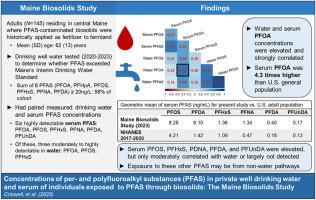私人水井饮用水和通过生物固体接触全氟烷基物质的个体血清中的全氟烷基和多氟烷基物质(PFAS)浓度:缅因州生物固体研究
IF 7.3
2区 环境科学与生态学
Q1 ENVIRONMENTAL SCIENCES
引用次数: 0
摘要
全氟烷基和多氟烷基物质(PFAS)是合成的持久性化学品,可污染食物和水系统,并对人类健康产生持久的负面影响。我们描述了居住在历史上曾将PFAS污染的生物固体作为肥料施用于农田的地区的成年人的住宅井水和血清PFAS浓度。在2023年,我们测量了145名参与者血清中的7种PFAS,这些参与者在前3年内由于靠近生物固体应用地点而在井水中测量了多达28种PFAS。参与者的年龄中位数为63(15)岁,58%为女性,71%居住在距离生物固体施用地点不到一英里的地方,58%的井水PFAS水平超过缅因州临时饮用水标准(∑6遗留PFAS≥20ng/L)。在井水中,50%的井中检测到PFOA、PFOS、PFOA、PFHxA、PFHpA、PFPeA、PFBA、PFHxS和PFNA,检测到21种独特的PFAS。井水中PFOA浓度最高[GM(GSD) 13.6(20.1) ng/L]。血清中可检测到的PFAS包括PFOA [GM(GSD) 6.1(4.9) ng/mL];卵圆孔未闭((4.1)8.3 ng / mL), PFHxS ((2.5) 1.4 ng / mL), PFNA ((3.8) 1.3 ng / mL), PFDA ((4.1) 0.40 ng / mL),和PFUnDA ((2.8) 0.17 ng / mL)。在血清和水中均可检测到的PFAS中,PFOA基质间相关性最强(0.72);其他PFAS有中等相关性(0.32 ~ 0.33)。综上所述,生活在历史上使用过pfas污染生物固体的地区的个体,其水和血清中PFOA浓度升高且高度相关。其他血清PFAS升高,但与水浓度中度相关,提示潜在的非水暴露途径。本文章由计算机程序翻译,如有差异,请以英文原文为准。

Concentrations of per- and polyfluoroalkyl substances (PFAS) in private well drinking water and serum of individuals exposed to PFAS through biosolids: The Maine Biosolids Study
Per- and polyfluoroalkyl substances (PFAS) are synthetic and persistent chemicals that can contaminate food and water systems and have lasting negative implications for human health. We described paired residential well water and serum PFAS concentrations among adults residing where PFAS-contaminated biosolids were historically applied to farmland as fertilizer. In 2023, we measured 7 PFAS in serum from 145 participants who had up to 28 PFAS measured in their well water within the 3 prior years due to proximity to a biosolids application site. Participants were median(interquartile range) 63(15) years, 58 % were female, 71 % lived less than a mile from a site of biosolids application, and 58 % had well water PFAS levels exceeding the Maine Interim Drinking Water Standard (∑6 legacy PFAS ≥20 ng/L). In well water, PFOA, PFOS, PFHxA, PFHpA, PFPeA, PFBA, PFHxS, and PFNA were detectable in >50 % of wells, and 21 unique PFAS were detected. Well water concentrations were highest for PFOA [GM(GSD) 13.6(20.1) ng/L]. In serum, detectable PFAS included PFOA [GM(GSD) 6.1(4.9) ng/mL)]; PFOS [8.3(4.1) ng/mL], PFHxS [1.4(2.5) ng/mL], PFNA [1.3(3.8) ng/mL], PFDA [0.40(4.1) ng/mL], and PFUnDA [0.17(2.8) ng/mL]. Of PFAS measured and highly detectable in both serum and water, PFOA had the strongest inter-matrix correlation (0.72); other PFAS had moderate correlations (0.32–0.33). In conclusion, individuals living in an area with historic application of PFAS-contaminated biosolids had elevated and highly correlated PFOA concentrations in water and serum. Other serum PFAS were elevated but moderately correlated with water concentrations, suggesting potential non-water exposure pathways.
求助全文
通过发布文献求助,成功后即可免费获取论文全文。
去求助
来源期刊

Environmental Pollution
环境科学-环境科学
CiteScore
16.00
自引率
6.70%
发文量
2082
审稿时长
2.9 months
期刊介绍:
Environmental Pollution is an international peer-reviewed journal that publishes high-quality research papers and review articles covering all aspects of environmental pollution and its impacts on ecosystems and human health.
Subject areas include, but are not limited to:
• Sources and occurrences of pollutants that are clearly defined and measured in environmental compartments, food and food-related items, and human bodies;
• Interlinks between contaminant exposure and biological, ecological, and human health effects, including those of climate change;
• Contaminants of emerging concerns (including but not limited to antibiotic resistant microorganisms or genes, microplastics/nanoplastics, electronic wastes, light, and noise) and/or their biological, ecological, or human health effects;
• Laboratory and field studies on the remediation/mitigation of environmental pollution via new techniques and with clear links to biological, ecological, or human health effects;
• Modeling of pollution processes, patterns, or trends that is of clear environmental and/or human health interest;
• New techniques that measure and examine environmental occurrences, transport, behavior, and effects of pollutants within the environment or the laboratory, provided that they can be clearly used to address problems within regional or global environmental compartments.
 求助内容:
求助内容: 应助结果提醒方式:
应助结果提醒方式:


